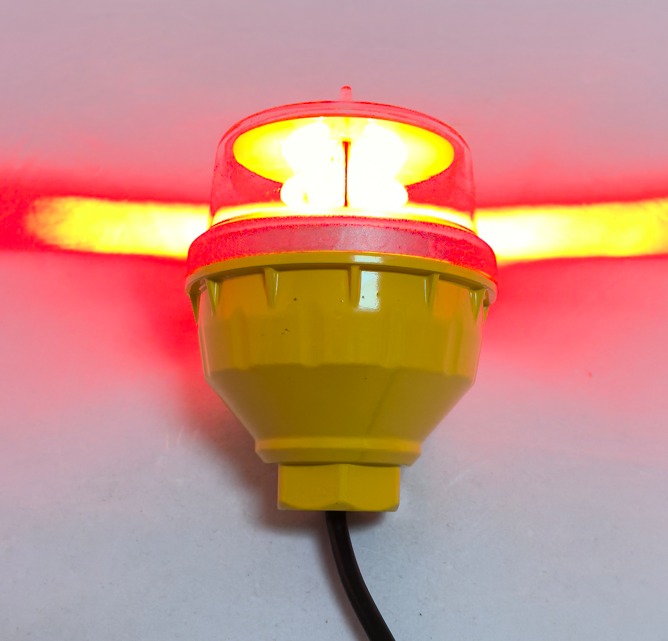In the realm of aviation and tall structure safety, obstruction lighting plays a pivotal role in preventing collisions and ensuring compliance with regulatory standards. Among the various lighting solutions available, the L810 obstruction light stands out as a widely recognized and reliable option. This article explores the significance, functionality, applications, and advancements related to the L810 obstruction light, highlighting its role in modern infrastructure and aviation safety.
Understanding the L810 Obstruction Light
The L810 obstruction light is a medium-intensity red beacon designed to mark tall structures such as communication towers, wind turbines, bridges, and buildings. Its primary purpose is to alert pilots to potential obstacles, particularly during nighttime or low-visibility conditions. The light meets stringent aviation safety standards, ensuring consistent performance in various environments.
Key Features of the L810 Obstruction Light
Medium-Intensity Red Light: Provides optimal visibility without causing glare or light pollution.
Durable Construction: Built to withstand harsh weather, including high winds, rain, and extreme temperatures.

Energy Efficiency: Often utilizes LED technology for lower power consumption and longer lifespan.
Compliance with FAA/ICAO Standards: Ensures adherence to aviation safety regulations worldwide.
Applications of the L810 Obstruction Light
Due to its reliability and compliance with international standards, the L810 obstruction light is used in multiple industries:
1. Aviation and Telecommunication Towers
Tall communication masts and antenna towers require obstruction lighting to prevent aircraft collisions.
The L810 obstruction light is commonly installed at critical heights to ensure visibility from a distance.
2. Wind Turbines
As wind farms expand, turbines—especially those exceeding 200 feet—must be marked for aviation safety.
The L810 obstruction light is often used in combination with other lighting systems for enhanced visibility.
3. Skyscrapers and High-Rise Buildings
Urban structures must comply with local aviation regulations, making the L810 obstruction light a preferred choice for marking rooftops.
4. Bridges and Offshore Structures
Marine and coastal infrastructure, such as offshore wind farms and bridges, rely on obstruction lighting to guide both aircraft and maritime traffic.
Regulatory Compliance and Standards
The L810 obstruction light is designed to meet key aviation safety regulations, including:
FAA (Federal Aviation Administration) Advisory Circular 70/7460-1L: Specifies lighting requirements for structures posing hazards to air navigation.
ICAO (International Civil Aviation Organization) Annex 14: Provides global standards for obstruction lighting to ensure uniformity in aviation safety.
EASA (European Union Aviation Safety Agency): Mandates specific lighting configurations for structures in European airspace.
Compliance with these standards ensures that the L810 obstruction light provides consistent and reliable performance, reducing the risk of accidents.
Technological Advancements in L810 Obstruction Lights
Modern iterations of the L810 obstruction light incorporate several innovations to enhance efficiency and sustainability:
1. LED Technology
Traditional incandescent bulbs are being replaced with energy-efficient LEDs, offering brighter illumination and longer operational life.
LEDs also reduce maintenance costs due to their durability and lower failure rates.
2. Smart Lighting Controls
Some L810 obstruction lights now feature adaptive lighting systems that adjust brightness based on ambient conditions.
Radar-activated systems can detect approaching aircraft, activating lights only when necessary to minimize light pollution.
3. Solar-Powered Options
In remote or off-grid locations, solar-powered L810 obstruction lights provide a sustainable alternative, reducing reliance on external power sources.
4. Enhanced Durability
Newer models are designed with corrosion-resistant materials, making them suitable for offshore and high-altitude installations.
Challenges and Future Trends
Despite its effectiveness, the L810 obstruction light faces challenges that drive ongoing innovation:
1. Light Pollution Concerns
Communities near tall structures often raise concerns about excessive nighttime lighting.
Solutions include directional lighting and adaptive systems that minimize unnecessary illumination.
2. Wildlife Impact
Certain bird species may be affected by obstruction lighting. Research is ongoing to develop wildlife-friendly lighting solutions.
3. Integration with IoT
Future L810 obstruction lights may incorporate IoT connectivity for real-time monitoring and predictive maintenance.
The L810 obstruction light remains a cornerstone of aviation and infrastructure safety, ensuring that tall structures are visible to pilots and compliant with global regulations. With advancements in LED technology, adaptive lighting, and sustainability, the L810 obstruction light continues to evolve, offering improved efficiency and reduced environmental impact.

